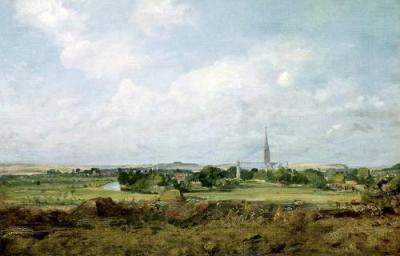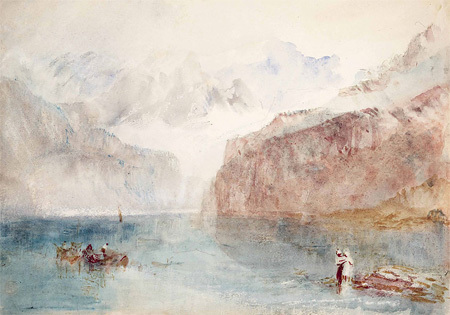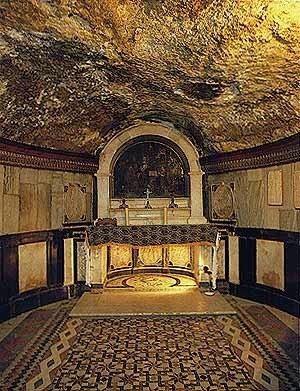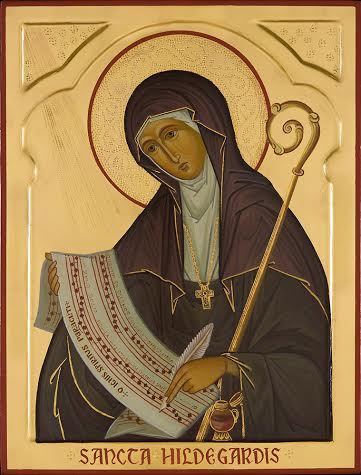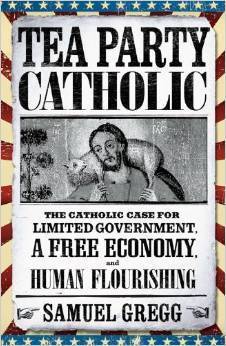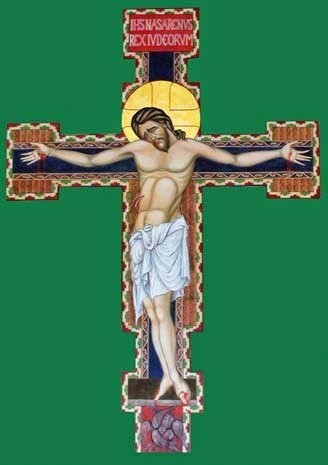David Clayton's Blog, page 22
May 12, 2015
Pocket oratories – aids to prayer in your wallet
 Thanks to Nanci Keatley who has just told me about her ‘pocket oratories’. Each one is a miniature hand-held iconostasis, which can be kept in your wallet or purse and is a focus for prayer. If you pause in the day, perhaps to pray the Office or the Rosary, this can be an excellent portable visual aid. Unbutton it and open it up and you can focus on the images in the palm of your hand as you pray. What a great idea this is!
Thanks to Nanci Keatley who has just told me about her ‘pocket oratories’. Each one is a miniature hand-held iconostasis, which can be kept in your wallet or purse and is a focus for prayer. If you pause in the day, perhaps to pray the Office or the Rosary, this can be an excellent portable visual aid. Unbutton it and open it up and you can focus on the images in the palm of your hand as you pray. What a great idea this is!
They are available here.
This one has icons from the Little Oratory book as well as the Sacred Heart.
May 8, 2015
Weekend Course on Sacred Art and the New Evangelization June 12-14 in Kansas City, Kansas
This offers more than teaching you about the New Evangelization – it tell you how to be part of it, a new person, transformed in Christ and through beauty, and showing Christ to others in our everyday activities
Dr Caroline Farey of the School of the Annunciation in Devon and myself will be teaching a weekend course, Sacred Art and the New Evangelization in Kansas City, Kansas for the weekend of June 12 -14. It will include talks from both of us and the praying of the liturgy of the hours through the weekend. Register here.
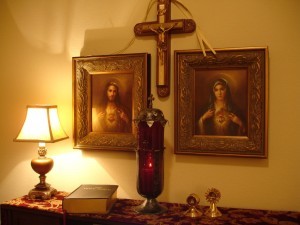 Pope Benedict said that he believes that the Domestic Church will be the driving force for the New Evangelization. With this in mind and as part of this course we will be praying the Liturgy of the Hours. The intention is that this will do more than simply bring the community of students and teachers together (which it will do); we hope to see those who attend take this away with them and introduce the practice to their families and parishes. The material we use is simple enough that people who can sing it easily and beautiful so that they want to. Anyone who can hold a pitch when they sing and is not afraid to sing in front of their friends can will be able to continue on their own or pass it on to others in their own homes and parishes afterwards and build communities in faith around them. So why not start thinking out of the box…or out of the cell? Take a beautiful simple Vespers into hospitals or prisons in a form that patients and prisoners and will want to sing with you? We can take Christ from the monk’s cell to the prisoner’s cell so that the two are synonymous.
Pope Benedict said that he believes that the Domestic Church will be the driving force for the New Evangelization. With this in mind and as part of this course we will be praying the Liturgy of the Hours. The intention is that this will do more than simply bring the community of students and teachers together (which it will do); we hope to see those who attend take this away with them and introduce the practice to their families and parishes. The material we use is simple enough that people who can sing it easily and beautiful so that they want to. Anyone who can hold a pitch when they sing and is not afraid to sing in front of their friends can will be able to continue on their own or pass it on to others in their own homes and parishes afterwards and build communities in faith around them. So why not start thinking out of the box…or out of the cell? Take a beautiful simple Vespers into hospitals or prisons in a form that patients and prisoners and will want to sing with you? We can take Christ from the monk’s cell to the prisoner’s cell so that the two are synonymous.
In conjunction with this, students will be taught how to pray with sacred art so that their icon corner really does become the focus of prayer and the heart of the home. We will learn, for example how the traditional layout of the icon corner reflects in both content and form the themes that Benedict brought out in his essay on the New Evangelization. This adds to the power of the prayer in the home to transform us supernaturally so that, despite ourselves and through God’s grace, people see Christ in us and they believe that He can give them what they want most in life.
The price for the weekend which includes room and board is just $250 which is extraordinarily good value.
For more details click link here or go to www.archkck.org/evangelization
May 4, 2015
The Landscapes of John Constable
 There are two difficulties with baroque landscape. First was the inclination in the 17th century baroque to represent those areas where the colour is muted in sepia. This meant that they very often gave the appearances of very deep shadow everywhere that was not the primary focus of interest. Second was the technical difficulty in describing the form of trees and foliage. It may sound like a small thing, but anyone who has ever tried to paint trees will know that they are fiendishly difficult to represent. The artist must give the sense of a united form, like a sponge, but also of one composed of many individual leaves. The paintings of trees from the earlier period tended, to my eye, to look to ‘feathery’. They focussed too much on the detail and not enough on the overall form. Turner overcame this in an idiosyncratic way by adopting the colour theories of Geothe for his tonal representation and, as far as I can see, avoiding painting any trees at all! Other artists overcame this problem by representing the tonal areas in a muted version of the original colour. So, in landscape this usually means toned down greens – grey greens, blue greens, brown greens although sometimes retaining sepia for deep shadow when the composition requires it. As with Turner, the choice depends upon two factors: consideration of whether or not the area being painted is in sunshine or shadow; and how far in the distance the area is. Distance and degree of illumination both of these factors affect our perception of colour and tone and so these two variable must be reflected in any scheme that the artist devises. John Constable (1776-1837) is happy to use compositions that involve deep shadow in the foreground and he uses sepia for these areas. But he also renders areas in sunshine well. He also seemed happy to turn his hand to a wide variety of landscapes and seascapes. His watercolours or sketches, painted in situ are of interest to the modern eye (or mine at least) because of the spontaneity with which they are rendered. These would not have been considered finished works of art at the time but preparatory works for the pictures done in the studio.
There are two difficulties with baroque landscape. First was the inclination in the 17th century baroque to represent those areas where the colour is muted in sepia. This meant that they very often gave the appearances of very deep shadow everywhere that was not the primary focus of interest. Second was the technical difficulty in describing the form of trees and foliage. It may sound like a small thing, but anyone who has ever tried to paint trees will know that they are fiendishly difficult to represent. The artist must give the sense of a united form, like a sponge, but also of one composed of many individual leaves. The paintings of trees from the earlier period tended, to my eye, to look to ‘feathery’. They focussed too much on the detail and not enough on the overall form. Turner overcame this in an idiosyncratic way by adopting the colour theories of Geothe for his tonal representation and, as far as I can see, avoiding painting any trees at all! Other artists overcame this problem by representing the tonal areas in a muted version of the original colour. So, in landscape this usually means toned down greens – grey greens, blue greens, brown greens although sometimes retaining sepia for deep shadow when the composition requires it. As with Turner, the choice depends upon two factors: consideration of whether or not the area being painted is in sunshine or shadow; and how far in the distance the area is. Distance and degree of illumination both of these factors affect our perception of colour and tone and so these two variable must be reflected in any scheme that the artist devises. John Constable (1776-1837) is happy to use compositions that involve deep shadow in the foreground and he uses sepia for these areas. But he also renders areas in sunshine well. He also seemed happy to turn his hand to a wide variety of landscapes and seascapes. His watercolours or sketches, painted in situ are of interest to the modern eye (or mine at least) because of the spontaneity with which they are rendered. These would not have been considered finished works of art at the time but preparatory works for the pictures done in the studio.
This is speculation on my part, but I wonder if this use of watercolour especially as the means of capturing the moment is influential the form of the finished works of the artists of this time. The finished studio based work will have been a composite of detail from a number of spontaneous sketches – and so in this case oil paint copies of watercolours. Turner almost seemed to use oil paint as though he was painting in watercolour – lots of thin washes.
Constable is one of the first that I know of to be able to render the balance of broad form and detail in foliage and trees well. He simultaneously represents the broad shape through light and dark, and provides some detail without overloading it, importantly, in a way that allows that mind to infer what the whole is comprised of. This is one of a series of article intended to read as such: Baroque Landscape Baroque Landscape: Chinese Baroque! Romantic Baroque: the Landscapes of William Turner Paintings above, from top: Lighthouse at Harwich; Wivenhoe Park
View of Salisbury
Cornfield
Weymouth Bay
Brighton Beach with Colliers
May 1, 2015
Appearance on Catholic TV to talk about beauty, the New Evangelization and the Way of Beauty online courses
Here’s a bit of bare-faced self-publicity (as opposed to my usual more restrained brand of self-publicity!)…I appeared on Catholic TV during the week talking about the Way of Beauty and the New Evangelization. I was invited on to talk about the new Way of Beauty online courses which have the Catholic TV series at their heart. The interview took place in Boston on Tuesday and was aired live.
April 28, 2015
Romantic Baroque: the Landscapes of William Turner
 It might seem contradictory that the landscapes of the Romantic movement (with which William Turner’s work is usually associated) are so beautiful. The Romantics of the 18th and 19th century were responsible in many ways for destroying the traditional forms that preceded them and opened the way to ugliness of modern art. Their emphasis on personal feelings and especially intense emotion of the artist is contrary to the traditional idea of painting in conformity to objective standards for the greater glory of God.
It might seem contradictory that the landscapes of the Romantic movement (with which William Turner’s work is usually associated) are so beautiful. The Romantics of the 18th and 19th century were responsible in many ways for destroying the traditional forms that preceded them and opened the way to ugliness of modern art. Their emphasis on personal feelings and especially intense emotion of the artist is contrary to the traditional idea of painting in conformity to objective standards for the greater glory of God.
There is a desire to communicate emotion in the baroque also, but it is not the emotion of the artist that is emphasized. Rather, it is the emotion of the person painted or sculpted that is portrayed. Bernini’s St Theresa of Avila, for example, reveals her emotional state, not his.
Subjectivity is not necessarily a bad thing however: when those subjective feelings coincide with what is objectively true, there is the possibility of something good. Broadly speaking, this is the case for Romantic landscapes, provided the desire of the artist is to communicate the beauty of nature (and other things being equal). The training the artists received in the 18th and 19th centuries was essentially the same as that from the previous period: which was an adaptation of the academic method – originally developed for the study of the human person -for landscape. It transmitted the baroque visual vocabulary of form without departing from core Christian principles (although steadily becoming more and more detached from a Christian understanding of them).
 As mentioned before, baroque landscape employed control of focus and intensity of colour that corresponded to the way that the human person naturally perceives the world around him. The inclination in the 17th century baroque was to represent those areas where the colour is muted in sepia. This meant that they very often gave the appearances of very deep shadow everywhere that was not the primary focus of interest. This of course, is not always appropriate. To overcome this artists started to become more sophisticated in the range of colours they used for those areas rendered tonally.
As mentioned before, baroque landscape employed control of focus and intensity of colour that corresponded to the way that the human person naturally perceives the world around him. The inclination in the 17th century baroque was to represent those areas where the colour is muted in sepia. This meant that they very often gave the appearances of very deep shadow everywhere that was not the primary focus of interest. This of course, is not always appropriate. To overcome this artists started to become more sophisticated in the range of colours they used for those areas rendered tonally.
The great English artist, William Turner developed a striking answer to the problem. Drawing on the colour theory of Goethe, he developed a system in which he rendered form tonally, but in a variety of colours rather than just sepia. It is not easy to discern a strict format, but broadly speaking and as best as I have been able to discern it, in the foreground he used yellow for those areas in sunlight, and red through to deep red ochre and finally sepia for shadow. Then those areas that are in the distance he used blues for sunlight and, violets and blacks for shadow. All this is varied subtly dependant also upon the natural colour of the objects. The skill needed to combine all of this and yet still give the painting an impressional unity is immense. What I have described applies to land, building and trees. His skies are rendered in blues, greys and if painting sunsets, red and yellow; and seas in this system seem to sit between the two because the water reflects the light of the sea and land.
It appears to me that in many of his watercolours, which would be painted quickly, he relies on this more (perhaps he is developing and perfecting the technique through them). In his oil paintings he uses this variation but the control is more subtle – after all the background areas, which these are, should be subordinate to the main foci of interest, which are going to be rendered more literally.
 Another feature of Turner’s art is the reduction of the area which is sharp focus (with a corresponding decrease in the areas which are painted blurred. The out-of-focus areas are painted as though in peripheral vision. Turner used to practice painting his peripheral vision. This accounts for the looseness of many of his works. However, he never abandons the points of focus altogether. The oil painting Snowstorm, left, for example, is almost all blurred blizzard, there is, nevertheless the sharp line of a mast and a daub of bright colour for the boat, so that the eye has somewhere to rest. Many of his later oils are painted as thin washes of colour, mimicking his watercolour method there are many of these in Tate Britain museum in London – I am not sure if Turner considered all of them finished although to the modern eye they look splendid.
Another feature of Turner’s art is the reduction of the area which is sharp focus (with a corresponding decrease in the areas which are painted blurred. The out-of-focus areas are painted as though in peripheral vision. Turner used to practice painting his peripheral vision. This accounts for the looseness of many of his works. However, he never abandons the points of focus altogether. The oil painting Snowstorm, left, for example, is almost all blurred blizzard, there is, nevertheless the sharp line of a mast and a daub of bright colour for the boat, so that the eye has somewhere to rest. Many of his later oils are painted as thin washes of colour, mimicking his watercolour method there are many of these in Tate Britain museum in London – I am not sure if Turner considered all of them finished although to the modern eye they look splendid.
What is interesting is that to my knowledge the colour theory of Goethe is not consistent with ideas of modern physics, yet it works well in Turner’s paintings. It may be a lucky inspiration (or perhaps there is something to Goethe after all!). Regardless of the validity of Goethe’s theories, the success of the paintings is a tribute to Turner’s great skill and intuitive sense of what works once he has painted it.
The paintings shown are watercolours except for Snowstorm, above and the two at the bottom of the series below, which are oils.
April 23, 2015
Two 11th century opus sectile floors in Jerusalem
I was contacted by an archeologist who is working on sites in Jerusalem who wondered if I knew anything of the origins of two opus sectile floor patterns that appear in the Church of the Holy Sepulchre and were laid in the 11th/12th century Crusader renovations of the church. The architect, Frankie Snyder tell me that the first shown below appears in 4 places:
1. Church of the Holy Sepulchre, Chapel of the Apparition (just north of the Rotunda) — late 11th century (with 20th century repairs to the starburst patterns)
2. Church of the Holy Sepulchre, Chapel of the Franks — 12th century
3. St. John the Baptist Church in Ein Kerem, under central dome — 12th century
4. St. John the Baptish Church in Ein Kerem, grotto, birthplace of John the Baptist, home of Zachariah — 12th century
5. Tile remnants of these tiles have been found on the Temple Mount, so there was evidently another chapel with this same floor built by the Crusaders on the Temple Mount during the 12th C.
And the second appears in 2 places:
1. Church of the Holy Sepulchre, Latin (Franciscan) Chapel of Calvary — 12th C (20th C replica of original)
2. Inside the Dome of the Rock — used by Crusaders as a church during the 12th C
All are made of local black bituminous limestone and hard red limestone, and imported white marble. All tile sizes seem to be based on the inch.
If anyone has any information please let us know. You can email Frankie on frankie.snyder@gmail.com
April 10, 2015
Two Beautiful Newly Completed Icons of Western Saints by Marek Czarnecki
I have just been sent images of these two beautiful icons of St Cecilia and St Hildegard of Bingen painted by Marek Czarnecki. Marek is a Catholic iconographer based in Connecticut. (www.seraphicrestorations.com). They were another pair of commissions for Our Lady of the Mountains in Jasper, Georgia. Fr Charles Byrd the pastor and the congregation have been working together to commission a whole series of new works of art in their little church.
Don’t forget the Way of Beauty online courses www.Pontifex.University (go to the Catalog) for college credit, for continuing ed. units, or for audit. A formation through an encounter with a cultural heritage – for artists, architects, priests and seminarians, and all interested in contributing to the ‘new epiphany of beauty’.
April 7, 2015
Why All Catholics Should be Interested in the American Constitution
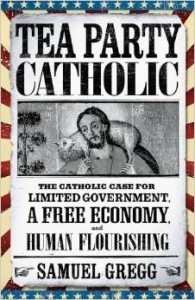 A book that explains why the American ideal of ordered liberty is consistent with a holistic view of human flourishing that is described in Catholic social teaching:
A book that explains why the American ideal of ordered liberty is consistent with a holistic view of human flourishing that is described in Catholic social teaching:
Tea Party Catholic: the Catholic Case for Limited Government, a Free Economy and Human Flourishing, by Samuel Gregg (www.teapartycatholic.com)
If you want to know what this book is about, at least read the whole of the front cover. If you got no further than Tea Party Catholic, it would be easy to mistake it as a piece of current affairs and contemporary social commentary. This is much more than that.
Although not unconnected with the values of the modern Tea Party movement that the title evokes, it is more a reference to the original Boston Tea Party and describes the influence of the sole Catholic signatory to the Declaration of Independence, Charles Carroll. Through papal writings especially those of Leo XIII, John Paul II and Benedict XVI he demonstrates that the free market, liberty, limited government and other ideas that characterize the American conservative mindset are consistent with Catholic teaching on the human person, freedom and capitalism. I suggest that it is important enough that it should be standard reading in the general education of all students – not just Catholics and not just Americans – for years to come.
For Catholics it is a great introduction to the basic principles of Catholic social teaching, freedom and the human person and the nature of a society in which the human person can flourish.
 For American Catholics and especially those who doubt that the American constitution and characteristic American values are consistent with the Catholic worldview, he demonstrates the harmony between the two visions of society. I have often felt that some are too quick seize upon the fact that each defines the terms ‘freedom’ and describes the human person differently and use it as a reason to dismiss the principles upon which America is founded as contrary to Catholic thinking. As Gregg explains although some of the language of the Founding Fathers is characterized by that of Enlightenment thinking - the principles that they are describing can be shown to be consistent the Catholic thought, developments in CST which occurred much later.
For American Catholics and especially those who doubt that the American constitution and characteristic American values are consistent with the Catholic worldview, he demonstrates the harmony between the two visions of society. I have often felt that some are too quick seize upon the fact that each defines the terms ‘freedom’ and describes the human person differently and use it as a reason to dismiss the principles upon which America is founded as contrary to Catholic thinking. As Gregg explains although some of the language of the Founding Fathers is characterized by that of Enlightenment thinking - the principles that they are describing can be shown to be consistent the Catholic thought, developments in CST which occurred much later.
If you could get any of them to read it, it would be an eye-opener to the large numbers of Europeans who are like I used to be: anti-American, anti-capitalist, anti-business and pro-socialist; who are taught to believe that the interests of business are fundamentally opposed to the good of society as a whole and the well being of the poor in particular; and have no knowledge of the principles upon which America was founded or any sense that they were even worthy of investigation.
This book will counter these prejudices on two fronts.
First, Gregg clearly articulates how Catholic social teaching describes the principles by which society can be ordered so that it is prosperous and the human person can flourish. Furthermore, CST is quite specific that this cannot include socialism and that a society that favors markets, the free economy, business and entrepreneurs, and is built on a culture of faith, morality and trust is the one that offers the greatest hope for all people, especially the poor.
 Second, his description of the meaning of traditional American values demonstrates, I believe, that America offers hope to the West in a time of crisis. The cultural foundation upon which so much that is good in the modern age and upon which the West is founded is more than Christian, it is Catholic. This being so, these American values which are so smugly rejected by many – especially the university educated – in fact represent a beacon of light in the West that is otherwise throwing away so much of its Christian heritage. If this is not stopped we are on a path to disaster.
Second, his description of the meaning of traditional American values demonstrates, I believe, that America offers hope to the West in a time of crisis. The cultural foundation upon which so much that is good in the modern age and upon which the West is founded is more than Christian, it is Catholic. This being so, these American values which are so smugly rejected by many – especially the university educated – in fact represent a beacon of light in the West that is otherwise throwing away so much of its Christian heritage. If this is not stopped we are on a path to disaster.
This last point could be noted as well, I think by many Americans who are, as I was surprised and somewhat dismayed to discover when I moved here, ashamed of their own culture and starry-eyed about Europe. Perhaps because I am English, it seems to bring this side out of them and they will quickly find a reason to apologize for their own culture and praise that of Europe, which they view as inherently superior. They identify European culture, I am guessing, with that which produced the beautiful buildings and art they see in European cities and do not seem to realize that modern European culture is far removed from the one that created these wonders.
If you want hope for the future it is not to Europe we must look, but to that part of American society that still espouses its traditional values and therefore, whether they know it or not, Catholic Social Teaching. That is not to say the American culture is perfect (although it is far better than most of these negative Americans and Europeans give it credit for). Rather it is that American society still has far more of what is necessary for such a transformation. From this starting point there is still, in my opinion, the possibility of infusing it with more so that it can be culture of greater beauty and in which the human person can flourish. My conviction about this arises not from a deep knowledge of the history of the founding of the United States, of which still am no expert, but from personal observations of American society. But I see support for this view in Gregg’s book.
 As Gregg put it it: ‘Subsidiarity tells us that the primary responsibility for limiting the temptations associated with the affluence generated by market economics lies with non-state organizations, especially families and churches. Parents are usually better placed than government officials to teach their children how to value material goods, to use mass media, and apply their minds critically to what they see and hear so that they can make clear judgments about what they are being told in advertising. The long-term goal is to root free markets in a moral culture that enables us live in societies akin to the Florence of the High Middle Ages and the Renaissance; communities in which widespread commerce, banking and trade went hand in hand with the literature of Dante and the art of Michelangelo.’
As Gregg put it it: ‘Subsidiarity tells us that the primary responsibility for limiting the temptations associated with the affluence generated by market economics lies with non-state organizations, especially families and churches. Parents are usually better placed than government officials to teach their children how to value material goods, to use mass media, and apply their minds critically to what they see and hear so that they can make clear judgments about what they are being told in advertising. The long-term goal is to root free markets in a moral culture that enables us live in societies akin to the Florence of the High Middle Ages and the Renaissance; communities in which widespread commerce, banking and trade went hand in hand with the literature of Dante and the art of Michelangelo.’
Well I might say Duccio or Giotto rather than Michelangelo but I don’t want to quibble! The point is very well made.
To read more and to buy the book go to www.teapartycatholic.com
Sam Gregg will be teaching at Acton University – the annual conference of the Acton Institute in Grand Rapids, Michigan, June 16-19 which is open to everyone, and thoroughly recommended to all.
Don’t forget the Way of Beauty online courses www.Pontifex.University (go to the Catalog) for college credit, for continuing ed. units, or for audit. A formation through an encounter with a cultural heritage – for artists, architects, priests and seminarians, and all interested in contributing to the ‘new epiphany of beauty’.
March 31, 2015
Lenten Art Meditations on streaming video by Fr Michael Morris
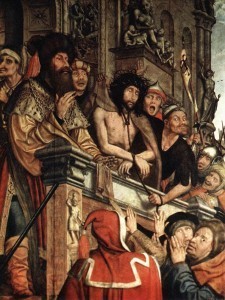 This is great stuff…but how do we make best use of the information?
This is great stuff…but how do we make best use of the information?
Here is an excellent series of recorded commentaries on works of art by Fr Michael Morris of the Dominican School of Philosophy and Theology. Fr Morris, who is on the full-time faculty of the school, heads their Religion and the Arts program and writes the sacred art meditations for the monthly Magnificat magazine. He has been posting one a week during lent and they call be viewed here. I encourage readers to visit this site watch these videos. At the end of this article is his meditation on the Ecce Homo by the Flemish artist Quentin Massys. The original painting is in the Prado in Madrid.
This does raise the question of what is purpose of such meditations? How do we make use of all the great information they contain? Do they help our participation in the liturgy? If so, how? If we cannot answer these questions satisfactorily then perhaps what we have here is just a bit of pious relaxation, one step up from vegging out in front of a documentary on the television – Catholic PBS!
The first point for each of us to ask ourselves, I suggest, is this: am I doing this as an exercise in understanding the work of art, or treating the work of art as a means for enhancing my knowledge and understanding of the Word. If it is the former then, and I speak for myself here, I am indulging in intellectual pride or a cultural affectation. I might as well be be taking a benign secular art history course which, while acknowledging the Catholic intentions of the artist, is detached from them.
Even if my goal is the latter – enhancing knowledge and understanding of the Word – then unless it is conformity to the ultimate end, it becomes another form of intellectual pride in which I am seeking theological knowledge and understanding, rather than artistic.
The answer has to be that, like all other human activity, it can be ordered to the purpose of deepening my participation the Sacred Liturgy, But how? Here is my approach:
I suggest that it is analogous to the study of scripture, which when done well internalizes what is learnt so that our worship of God is more worthy. This last point raises yet another additional question. If meditation of art is analogous to study of scripture, why bother with the study of art at all? Why not just study scripture directly?
The answer is given to us in the Catechism. In the first item that comes under the heading Truth, Beauty and Sacred Art, we read: ‘Truth is beautiful in itself. Truth in words, the rational expression of the knowledge of created and uncreated reality, is necessary to man, who is endowed with intellect. But truth can also find other complementary forms of human expression, above all when it is a matter of evoking what is beyond words: the depths of the human heart, the exaltations of the soul, the mystery of God.’ (CCC 2500)
This suggests then that the words of the art meditation are just a first step. They lead us into a receptivity of those aspects of the work of art that is not said in the mediation, and which are ‘beyond words’. This is a passive, contemplative mode of study. It is, when understood in this way, a sort of visual lectio divina. This is not a new idea, Claire of Assisi, for example, is often credited with the development of a technique of meditating art in this way. I suggest that in fact, unless art is studied in conjunction with this contemplative mode, then one might as well just be reading the theology truths contained from a written script. For we are not gaining beyond the words by looking at the picture.
And then we must go further still. Just as Benedictine spirituality as outlined in the Rule does not end with lectio divina but rather with the Opus Dei, the work of God – worshiping him in the Sacred Liturgy – so our meditation and contemplation of art must be directed towards this higher goal.
There are two ways in which this can be so, I suggest. The first, is an intellectual process that transforms us – those aspects of the Word that have been internalized by both meditation and contemplation are brought to the altar and affect our response in the Eucharist.
The second is that the meditation and contemplation of the art has developed our faculties of meditation and contemplation to a higher place. So when our worship is done in conjunction with appropriate holy images we use those faculties within the context of worship and are more engaged with that imagery in a way that raises our hearts and minds to God in our worship. Those truths that are beyond words are with us in the liturgy too.
This last point presupposes, of course, that there is some decent liturgical art where the liturgy is taking place!
As students we are more likely to make this connection right up the hierarchy of ends and put it into practice if we are made aware by our teachers and develop the habit of using art work in our prayer and especially in the liturgy. Without this there is a real danger that such meditations will be just the empty intellectual exercises that give academia a bad name.
The Church tells us that when it offers a Catholic education, ‘A school is a privileged place in which, through a living encounter with a cultural inheritance, integral formation occurs.’ ( The Catholic School, 26; pub. The Sacred Congregation for Catholic Education, 1977) This encounter with our cultural inheritance is not a ‘living’ encounter that provides ‘integral formation’ unless it is in conformity with its highest purpose – the worship of God in the Sacred Liturgy. It is the job of those us who teach to transmit this to our students how to use the information we give well, in conformity with our ultimate end, otherwise we let them down…and waste many wonderful resources such as those provided by Fr Morris.
Don’t forget the Way of Beauty online courses www.Pontifex.University (go to the Catalog) for college credit, for continuing ed. units, or for audit. A formation through an encounter with a cultural heritage – for artists, architects, priests and seminarians, and all interested in contributing to the ‘new epiphany of beauty’.
March 23, 2015
The New Evangelization and the Domestic Church – Pope Benedict XVI on the connection between the two
 Why the beauty of the prayer corner in the family home is crucial to the New Evangelization
Why the beauty of the prayer corner in the family home is crucial to the New Evangelization
The New Evangelization has become a buzzword of the age. Used by Pope St John Paul II it refers to the need to reach the faithless in the West whose parents and grandparents were Christian. But how do we reach these people who have no faith, but think they already know enough about Christianity to be hostile to it.?
In a short and clear paper written in 2000 Benedict XVI outlined what he believes is the answer to this question. If people are to convert they must believe that the Church has the answer to the fundamental question: ‘Which is the path to happiness?’ We do not tell people the answer to this question, he says, so much as show them. By the example of our own happy lives and loving interactions we show Christ to others. And the only way we can do this is to strive to be walking icons of Christ supernaturally transformed so that we participate in the ‘light’ of the Transfiguration.
There were two aspects of the Christian message that Pope Benedict felt would resonate today particularly when communicated in this way. First is that we demonstrate Christian joy that transcends human suffering so that in our own small way (or sometimes not so small) we bear suffering joyfully and with dignity as the martyrs did.
Second is that we should communicate the fact of life after death and a just and merciful judgment by Christ. When we have joyful hope for a future that reaches beyond death, fear is dispelled and we are given a purpose in this present life (anticipating themes discussed later in Spe Salvi in much greater depth). Again this is more powerfully transmitted in the way we are than by us telling people directly that we are joyful and free of fear.
How can we possibly live up to this ideal? The answer is that left to our own devices we can’t, but with God’s grace we can. The foundation of such a transformation says Benedict, is prayer.
Benedict describes prayer life that is a balance of three different sorts of prayer all ordered to the Eucharist. These are, first, the Sacred Liturgy – the Mass and the Liturgy of the Hours; second, ‘para-liturgical’ prayers which are devotional prayers said in common such as the rosary; and third personal prayer which is said alone and in private.
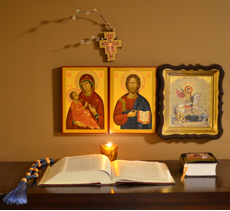 Most of us do not know how to pray well without being taught. Even the apostles asked Christ to teach them how to pray and Benedict tells us that we need ‘schools of prayer’ where we may learn to pray this transforming prayer.
Most of us do not know how to pray well without being taught. Even the apostles asked Christ to teach them how to pray and Benedict tells us that we need ‘schools of prayer’ where we may learn to pray this transforming prayer.
The most powerful and ideal school of prayer is the domestic church – the family home – where children learn by seeing the example of their parents (and I would say, especially fathers) praying to God, visibly and audibly to the image corner. Benedict tells us that the domestic church is an essential aspect of the new evangelization:
‘The new evangelization depends largely on the Domestic Church. The Christian Family to the extent it succeeds in living love as communion and service as a reciprocal gift open to all, as a journey of permanent conversion supported by the grace of God, reflects the splendor of Christ in the world and the beauty of the divine Trinity.’
So, he seems to be saying, if we did not learn to pray in our own home (perhaps because you are a convert like me), we have a responsibility to learn and then to pray at home so that we each create our own domestic churches.
Outside the family, a spiritual director is the best way to learn. These are hard to come by and so the next best thing is to look at books on prayer, Thomas Dubay’s for example are good and of course one of the four sections of the Catechism is devoted to it.
The book, the Little Oratory, A Beginner’s Guide to Praying in the Home was written by myself and Leila Lawler with this aim in mind. (The word ‘oratory’, incidentally, derived from the Latin orare - to pray – means literally ‘house of prayer’.) In this we pass on the guidance we were given when we asked of others that question, ‘teach us how to pray’. It describes how to order prayer in accordance with the hierarchy that Benedict describes so that it lightens the load of daily living rather becoming a burden. It addresses directly how to arrange the images for the icon corner in the home and how to pray to visual imagery.
The traditional layout for the core imagery of the icon corner is as follows: in the center should be the suffering Christ, that is Christ on the cross; to the left should be an image of Our Lady; and to the right should be an image of the glorified Christ (perhaps a Veronica cloth or Christ Enthroned with angels).
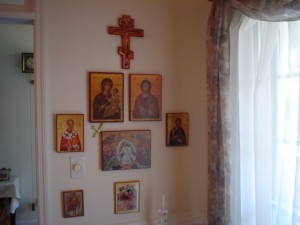 It seems that nearly every aspect of the Faith is contained in some way in just these images and there simply isn’t room to talk about it all here. However, it is interesting to note that they speak directly to the concerns that Benedict brought out in regard to the new evangelization: Christ on the cross is the most poignant symbol of consolation in our suffering; and all images of Christ glorified communicate to us the glory of heaven and what is in store for us through deification. This is the transformation by which we participate in the divine nature through Christ. It happens by degrees in this life through participation in the sacramental life.
It seems that nearly every aspect of the Faith is contained in some way in just these images and there simply isn’t room to talk about it all here. However, it is interesting to note that they speak directly to the concerns that Benedict brought out in regard to the new evangelization: Christ on the cross is the most poignant symbol of consolation in our suffering; and all images of Christ glorified communicate to us the glory of heaven and what is in store for us through deification. This is the transformation by which we participate in the divine nature through Christ. It happens by degrees in this life through participation in the sacramental life.
Iconographic images of the face of Christ are always painted with an expression of compassion tinged with a slight sternness. This enigmatic combination tells us that Christ is a judge (hence the sternness), but that he is a good and merciful judge.
Finally, the role of Mary is crucial in the new evangelization, I believe. All that the Mother of God does is directing us to her son. We see this portrayed directly in many images of Our Lady – she engages us with her eyes while gesturing towards her son.
How will the domestic church evangelize the un-churched? At first sight it is not clear – it is possible that the images of the domestic church might communicate these truths to the faithless directly, who are invited into our homes, for example, but it is unlikely. That is not the point. The idea is that they are placed in the homes of the faithful for the effect it has on us. The beauty of sacred art communicates something that words alone cannot. When we pray with holy images, especially liturgical prayer as in the Divine Office, what we see impresses itself on our souls and we are raised up to the ideals they portray . Despite ourselves in many cases, we are transformed, partaking in the divine nature so that we may show Christ to others. As we leave our homes and go about our daily business, engaging with our fellows in a secular society, people see in us something greater, the divine person. It is Christ who affects those people, through us. It is a lay ‘in persona Christi’. In so doing we emulate also, in our own diminished way, the life of Our Lady showed her son to us and prays for us to Him constantly.
I painted the images below as examples that would be appropriate for an icon corner in a Domestic Church. In addition to the three core images – the face of the glorified Christ, Christ on the cross and Our Lady of Merrimack. The first is in a traditional iconographic style and the other two are in a Western gothic style.
In addition is the image of the Knight of the New Evangelization which I have painted as a symbol of the mission of the Church today. He portrays the need for chivalry and virtue in today’s culture which is hostile to Christianity. The battle in the West is spiritual but nevertheless requires courage. The image is based on one from the 13th century Westminster psalter painted by Matthew Parris
Don’t forget the Way of Beauty online courses www.Pontifex.University (go to the Catalog) for college credit, for continuing ed. units, or for audit. A formation through an encounter with a cultural heritage – for artists, architects, priests and seminarians, and all interested in contributing to the ‘new epiphany of beauty’.
David Clayton's Blog
- David Clayton's profile
- 4 followers







